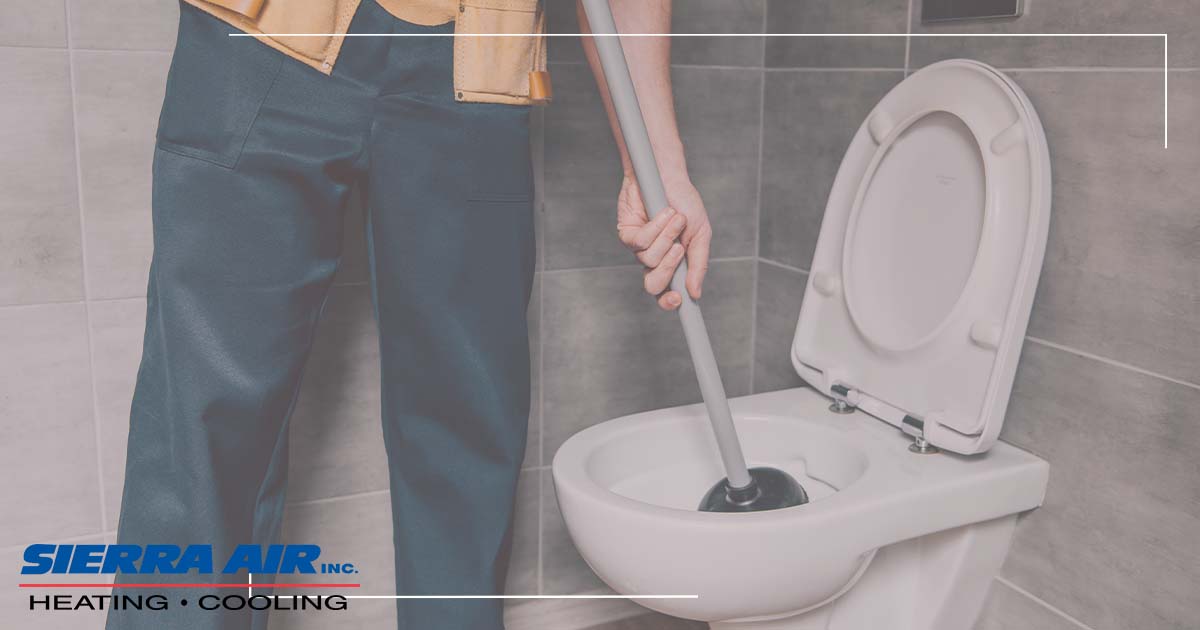If you’re in your own bathroom – or someone else’s – and have an overflowing toilet, you have to take immediate action to keep the bowl from flooding the bathroom. It’s not only scary, but it’s embarrassing.
Most people know how to handle simple clogs, but an overflowing toilet could be a stubborn clog that needs a little more finesse. Here’s what you should do if you experience an overflowing toilet.
First, Stop the Water Flow
If your toilet has a water shut-off valve, this is the easiest way to stop the water flow and give yourself time to plunge. It’s usually located near the wall where the toilet connects. Once you find the valve, turn it clockwise to shut off the water.

Another option is to close the flapper in the tank. You’ll have to move quickly, but you can open the lid and push the flapper down into the hole to stop water from flowing into the tank. This is a round rubber piece that’s usually a bright color and has a chain or metal lever attached. Once it’s closed, the flapper seals off the tank and bowl.
If you think the toilet may overflow before you flush, get ready by opening the tank and finding the flapper. Then use your other hand to flush the toilet. If it begins to overflow, you can plug the flapper quickly.
Whatever you do, don’t flush again! This will only add more water to the tank, since these types of clogs are usually a full blockage. Adding more water may turn a high water level into a full overflow.
Plunge the Toilet
Now that the water is under control, you can plunge without the stress of water entering the bowl. Depending on how high the water level is, you may need to use a bowl or bucket to remove a few inches of water and give yourself some space to plunge.
Once that’s done, put on gloves and grab the plunger. Many homes have a standard plunger, but a flange plunger is the best choice to create a tight seal and clear the clog quickly. These plungers have an elongated flange on the end that fits well into the toilet drain hole to make a proper seal.
If the plunger is stiff, it may help to loosen it up with hot water. Run it under hot water for a few seconds to heat the rubber and make it more pliable, so you can maneuver it to create a better seal.
Plunging itself is simple, but not if you don’t know how to use a plunger properly. Most people only focus on the downward strokes, but it’s the combination of upward and downward motions that loosen the clog and move it through the pipes.
How To Unclog A Toilet With Baking Soda
After you get a tight seal, use strong, smooth, consistent up and down motions with the plunger, minding the seal. Don’t plunge furiously. It won’t help, as you’ll lose the seal without controlled movements.
Sometimes, loosening the clog is enough to move the water into the drain and have it flush normally. If that doesn’t happen, you can try flushing after plunging to see if it works. Just be prepared to close the flapper and stop the water flow if it begins overflowing again. You may need to plunge a few times to break up the clog.
Try a Natural Remedy
If the clog isn’t loosening up, don’t reach for chemical clog removers. These products have highly corrosive chemicals that will damage the porcelain in the toilet.
Instead, use the plumber’s secret of hot water and dish detergent. Both of these are safe for your toilet and can loosen up the clog to make it easier to plunge. Just add some hot water and a squirt or two of dish detergent before you plunge.
Another option that works well if you can wait is baking soda and vinegar. These ingredients are great for breaking up clogs with a harmless chemical reaction. Just add one cup of each to the toilet bowl and leave it sit for eight hours, then try to clear it again.
Should You Call a Plumber?
If you’re plunging and not getting anywhere, it may mean there’s a bigger problem in the toilet. For example, children may put toys in the toilet that can cause severe blockages. In this case, plunging will only help to bring up the toy, but calling a plumber is the best bet.
Clogs will happen from time to time, but if your toilet clogs constantly, there may be an issue lurking deeper in your system. If this is the case, bring in a plumber to correct the underlying issue, not the symptom (the clog).
Need plumbing help for your bathroom? Contact us at Sierra to schedule your appointment!




